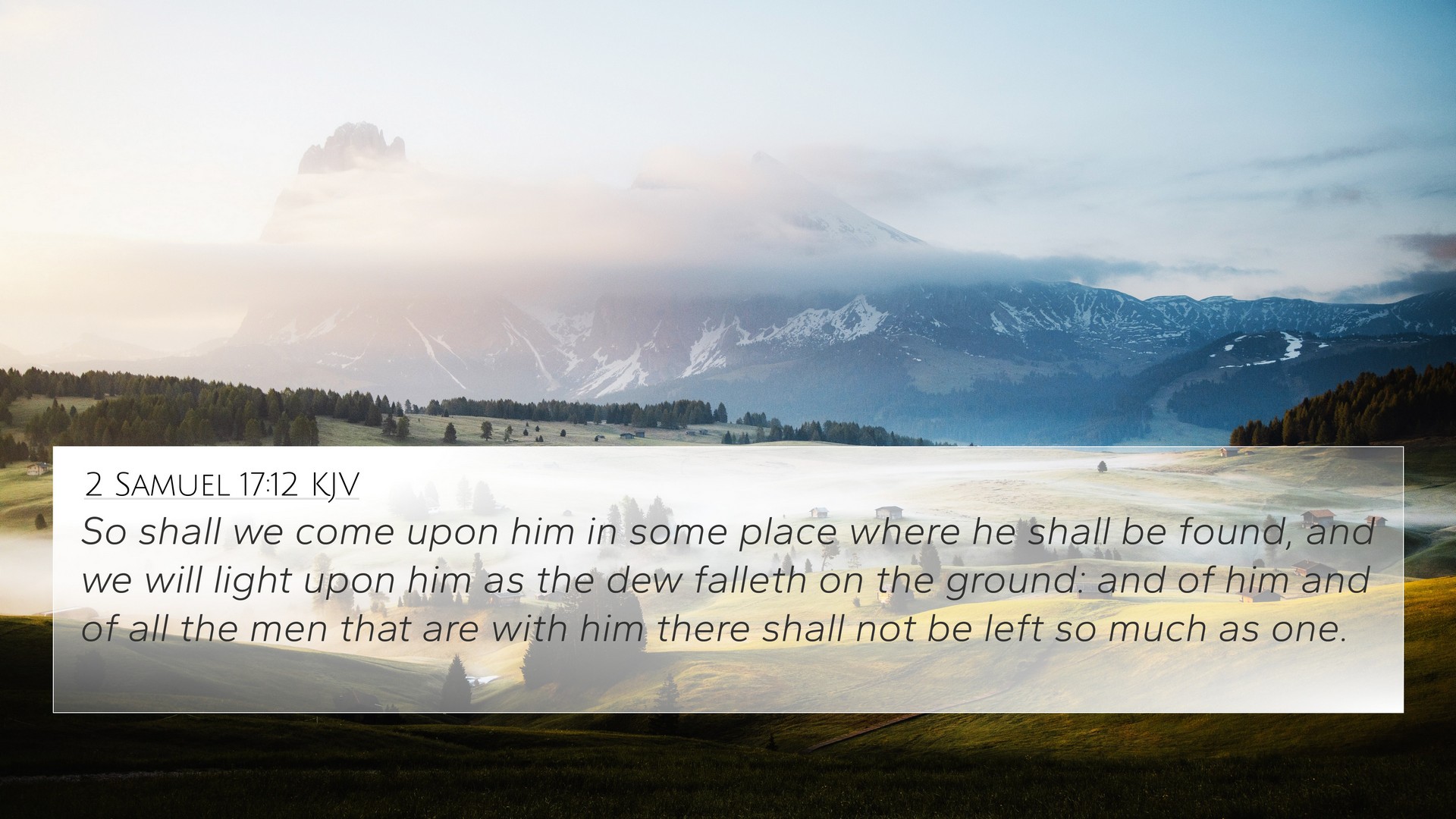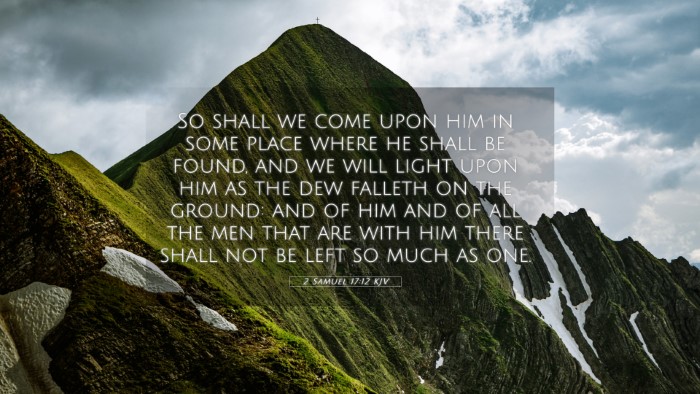Understanding 2 Samuel 17:12
2 Samuel 17:12 states: "So shall we come upon him in some place where he shall be found, and we will light upon him as the dew falleth on the ground. And of him and all the men that are with him there shall not be left so much as one."
This passage occurs during Absalom's rebellion against David, as Ahithophel provides counsel on how to pursue David. The verse articulates a sense of strategy and stealth in approaching the king, highlighting the urgency and cunning nature of conflict during this turbulent time.
Summary of Insights from Public Domain Commentaries
-
Matthew Henry:
Henry expounds on the calculated nature of Ahithophel's advice. He notes that the imagery of dew is particularly significant, symbolizing the sudden and overwhelming nature of their attack. They aim to catch David off-guard, emphasizing the importance of timing and stealth in their strategy.
-
Albert Barnes:
Barnes furthers the analysis by connecting this tactic to the greater theme of betrayal and conflict within families, specifically between David and Absalom. He argues that this betrayal signified not only a personal vendetta but also a divine display of judgment on David's past sins.
-
Adam Clarke:
Clarke highlights the metaphor of “dew,” noting its quiet yet pervasive descent—an apt illustration of the impending ambush. He expresses how the verse encapsulates the tension of the moment, underlined by the desperation and enmity brewing in the hearts of Absalom's followers.
Cross-References Relevant to 2 Samuel 17:12
- Psalms 3:1-2: A lament of David during Absalom’s uprising.
- 2 Samuel 15:12: Absalom’s conspiracy is initiated.
- 2 Samuel 16:15: Absalom enters Jerusalem, showcasing his political power.
- 2 Samuel 18:14: The ultimate attempt to capture David - illustrating the violence that ensues.
- 2 Samuel 15:31: David learns of Ahithophel's betrayal, connecting to the broader theme of treachery.
- Psalms 41:9: A reflection on betrayal within relationships.
- Proverbs 1:18: The schemes of the wicked often lead to their own destruction.
- John 18:12: A parallel of betrayal, related to Judas's betrayal of Christ.
- Lamentations 3:66: A cry for the downfall of enemies, sharing thematic resonance with Absalom’s pursuit.
- Matthew 26:47-50: Another example of betrayal, relating to personal conflict.
Thematic Connections
The verse illustrates the overarching theme of betrayal, conflict, and divine judgment evident throughout the narrative of David and Absalom. Insights from cross-references deepen our understanding of both historical and moral lessons, enabling us to explore connections between Bible verses and linking Bible scriptures to relate the human experiences faced by these Biblical figures to contemporary life.
Applying Cross-Referencing Techniques
To gain a comprehensive understanding of 2 Samuel 17:12, utilizing various tools for Bible cross-referencing such as concordances and thematic studies can enrich Bible study. By identifying the Bible verses that relate to each other, one can uncover a deeper narrative connecting past events to present teachings.
Example Cross-Referencing Methods
-
Identifying Connections: Look for themes that resonate with personal experiences or conflicts in your life.
-
Thematic Studies: Group verses by common themes such as betrayal, conflict, or divine justice.
-
Comparative Studies: Examine verses from different books that convey similar messages or reflect back to earlier narratives.
User Intent and Outcomes
Understanding the connections within Scripture helps answer questions like "What verses are related to 2 Samuel 17:12?" or "How do 2 Samuel 17:12 and Psalms 3 relate?". Each verse contributes to an overarching narrative that teaches about human nature and divine sovereignty.
Through diligent study and cross-referencing techniques, one can explore the profound depths of Scripture and how various stories and teachings interrelate. Finding cross-references not only broadens personal understanding but enriches the overall interpretation of the Biblical text.








